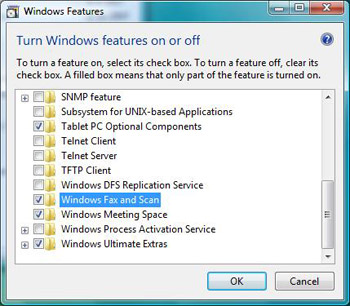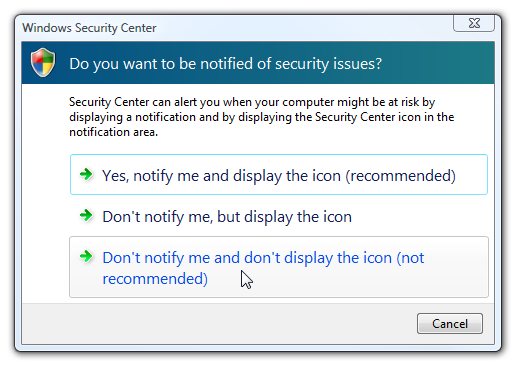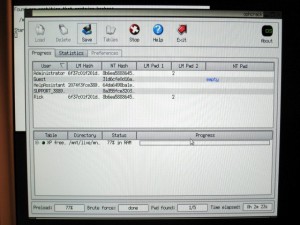Windows Vista is a much maligned operating system, mainly because people say it:
- is slower than Windows XP
- has a silly security system requiring multiple clicks just to delete a file
- looks bad with all the Aero effects
While Microsoft is working to fix these and other problems in Windows 7, these problems can also be fixed today for most people by following these modifications
Note: Only make the changes that you understand and feel comfortable with. Also, if you already have a fast machine there is no need for most of these changes.
1. Turn off Windows Features
Turn off unneeded features by going to:
Start – Control Panel – Uninstall a Program (Under Programs) – Turn Windows Features on or off (on left Task panel)

From here, you can uncheck everything you would like to. On my system, I deleted everything except:
- Some of the games
- XPS Viewer (under .NET Framework 3.0)
- Remote Differential Compression (a network optimizer)
- Windows Ultimate Extras
2. Consider Disabling Security Center
Security Center is useful, but if you have a firewall, antivirus software, and you are comfortable with the idea, you can disable the Security Center. Open the Security Center from the System Tray in the bottom right. Then click Change the way Security Center alerts me on the left pane. Then select the last option, Don’t notify me and don’t display the icon (not recommended). To finish disabling security center, follow the instructions below in services.msc.

3. Disable Services in services.msc
Services.msc shows you all the services that can run on the computer. Go to:
Start
Then type in the text area (where it says Start Search) services.msc and hit Enter
Services are under the Startup Type categories:
- Automatic – service starts when Windows starts.
- Manual – service starts when Windows detects that something needs it.
- Disabled – service doesn’t start at all.
You can look for automatic services and change them to manual or disabled. Right click and choose Properties for the option to change the Startup Type. TweakHound has a Vista Services Guide listing the services and what they are used for.
This is the list of services that most people can disable:
- Computer Browser
- Distributed Link Tracking Client
- IKE and AuthIP IP Keying Modules
- Offline Files
- Remote Registry
- Tablet PC Input Service (unless you’re using a tablet PC)
- Windows Error Reporting
Other services to consider diabling include:
- DFS Replication
- Distributed Link Tracking Client
- IP Helper
- IPsec Policy Agent
- KtmRm for Distributed Transaction Coordinator
- Secondary Logon
- Security Center (as noted in the above Consider Disabling Security Center)
- SSDP Discovery
- Terminal Services
- Windows Defender
Be sure to NOT disable:
- Multimedia Class Scheduler
- Plug and Play
- Superfetch
- Task Scheduler
- Windows Audio
- Windows Driver Foundation
4. Remove System Tray and msconfig items
Go to the system tray in the bottom right and remove programs that you do not need to be running, or at least remove their system tray portions if you do not need them. This is often available in the application preferences or options. You can also remove services and system tray items by typing in the start bar (where it says Start Search) msconfig and hit Enter
Each of the tabs show startup items that you can edit. There are usually items like iTunes helper, Quicktime, and AOL that are listed here. Even if you use those programs, you may not want them to start up automatically if you use those programs less frequently. They typically allow an app to start up more quickly, but at the price of always running and taking up computer resources.
5. Update your drivers
Device drivers are often updated for motherboards, chipsets, graphics. You can get a boost in performance by checking your drivers for updates. Go to:
Start – Control Panel – Hardware and Sound – View hardware and devices (under Device Manager)
From there you can right click on devices and select Update Driver Software.
6. Use ReadyBoost
ReadyBoost is a feature that uses a flash drive (thumb drive) or memory card (SD card or other) for caching data so that it does not need to be read from the hard drive. Microsoft recommends using a drive one to three times the size of the system RAM. So if you have 2GB of RAM, use a ReadyBoost flash drive of 2GB to 8GB in size.
ReadyBoost is particularly useful if you have a small amount of RAM (512MB – 1GB).
Hard drives are great for large sequential I/O. For those situations, ReadyBoost gets out of the way. ReadyBoost concentrates on improving the performance of small, random I/Os, like paging to and from disk.
7. Remove Transparency
Personally, I find the transparent bars at the top of Windows ugly. They also take up video processing resources.
Go to:
Right-click on the desktop, Personalize, Windows Color and Appearance. Uncheck Transparency
8. Stop the Sidebar
While pretty, the Sidebar takes up memory. Right-click on the sidebar, select Properties, uncheck Start Sidebar When Windows Starts. To get the sidebar back, type sidebar into the start bar.
9 . Shoot the Aero
I prefer Windows Vista Basic to the Aero visual effects. Aero also puts a heavy hit on the computer’s video resources.
To remove Aero, right-click on the desktop, select Personalize, and then Windows Color and Appearance. Click Open Classic Appearance Properties and choose a theme in the Scheme list.
10. Run occasional Defrags
Disk deframenting still helps computers that have been used for some time. But Vista is scheduled to defrag every week. You should defragment whenever you want and turn off the scheduled defrags. Type defrag into the Start area and hit Enter.
11. Turn off Anti-Virus
Yes, it’s a little dangerous. But removing antivirus software, especially standards such as Norton and McAfee will free a lot of resources.
12. Use Vista
Over time, Vista’s speed should improve as it learns how you use it, through a system called Superfetch. This takes often used files and moves them to the outer edge of the disk because the outer edge of the disk is the fastest part. Vista does this by default.



